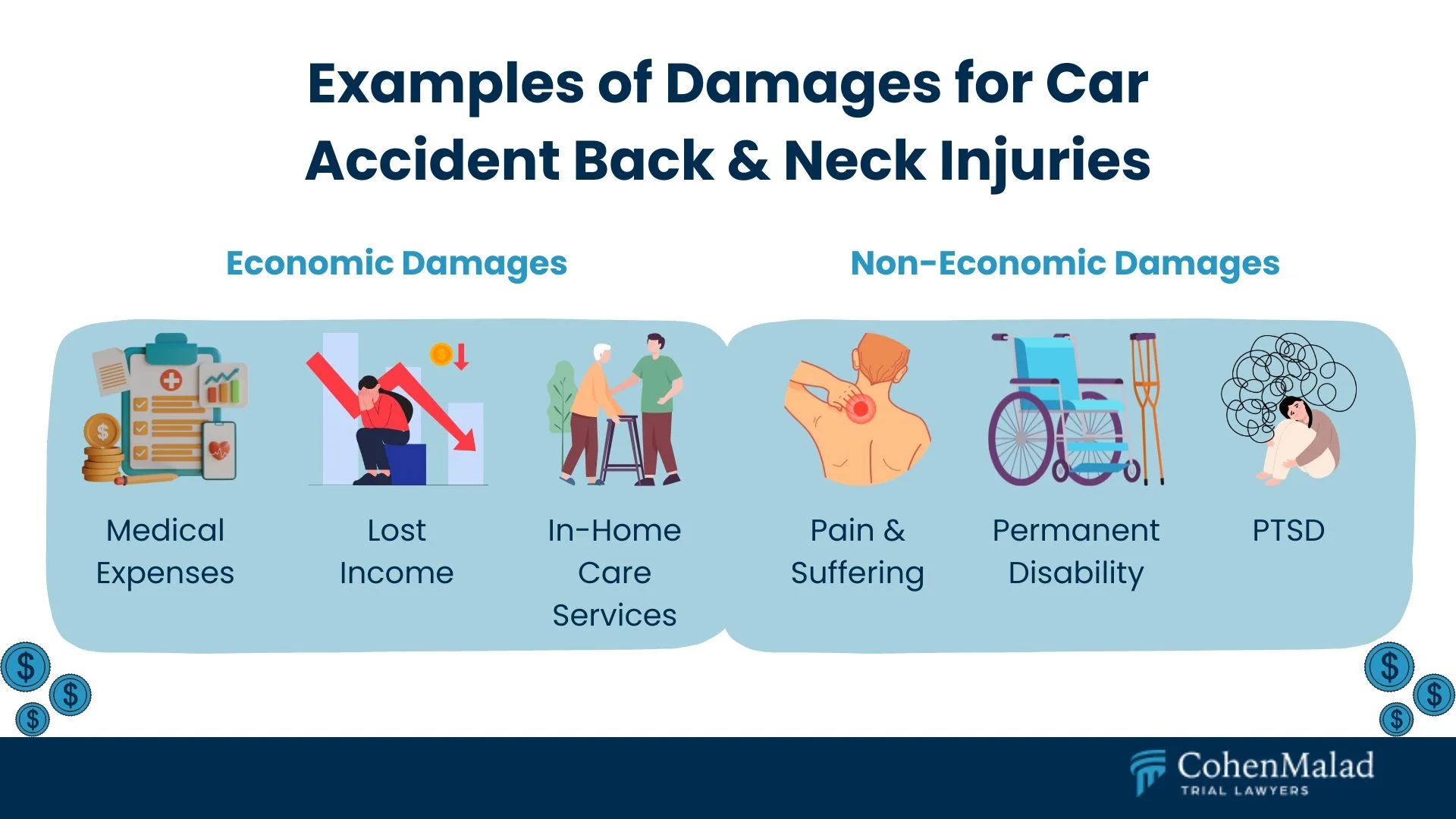Back and neck injuries rank among the most common and potentially life-altering consequences of motor vehicle accidents. In many instances, the neck and back pain will not go away, despite months of physical therapy and medications. The physical pain, emotional distress, and financial burden these injuries create can cause problems with sleep and stress on family relationships. It’s often overwhelming for victims.
If you've suffered a neck or back injury in a collision, understanding the potential settlement value of your case is crucial. Our Indiana car accident attorneys regularly help clients win fair compensation, which reflects the true nature of the long-lasting symptoms and consequences these injuries can cause.
How Much Is the Average Settlement for a Back or Neck Injury?
Settlement values for back and neck injuries from car accidents in Indiana vary considerably based on the injury's nature and impact on the victim’s life.
The table below provides a general overview of potential settlement ranges:
Factors That Determine Your Neck or Back Injury Settlement Value
Several important elements influence how much compensation you may receive for your neck or back injury after a car accident. Understanding these factors can help set realistic expectations about your potential settlement.
1. Injury Severity
The severity of your neck or back injury serves as one of the most influential factors in determining your settlement amount. Minor soft tissue injuries like muscle strains typically result in lower compensation values, while moderate injuries such as herniated discs command substantially higher settlements. Severe injuries, including spinal cord damage, often lead to the most significant compensation awards.
2. Extent of Medical Treatment
The level and duration of medical treatment directly affect settlement values. More extensive treatment generally leads to higher settlements, as it demonstrates the seriousness of your injuries. This includes emergency care, diagnostic tests, medication, physical therapy, chiropractic care, surgery, and any assistive devices. Documentation of all medical procedures is crucial evidence in establishing your claim's value.
3. Pain and Suffering

This non-economic damage compensates for the physical discomfort and emotional distress caused by your injury. Insurance companies often calculate the total settlement amount by the pain & suffering multiplier method, applying a number between 1.5 and 5 to your economic damages based on injury severity. More severe injuries with ongoing pain receive higher multipliers. A herniated disc causing chronic pain might use a multiplier of 3-4, while a minor whiplash injury might use a multiplier of 1.5-2.
4. Lost Income
When neck and back injuries prevent you from working, you're entitled to compensation for lost income. This includes not only past wages already lost but also projected future earnings if your injury causes long-term work limitations. Calculating lost wages requires documentation of your regular income, missed work time, and potentially expert testimony regarding diminished earning capacity.
5. Permanent Impairment
If your back or neck injury results in permanent disability or impairment, your settlement value increases substantially. Permanent injuries that limit mobility, cause chronic pain, or require ongoing medical care justify higher compensation. Insurance companies assess the long-term impact on your quality of life and ability to perform daily activities when calculating permanent impairment damages.
6. Pre-Existing Conditions
Prior neck or back problems can complicate your injury claim. Insurance companies often try to attribute your current symptoms to pre-existing conditions rather than the accident. However, you can still recover compensation if the collision worsened your condition (known as an "aggravation" of a pre-existing condition). Medical documentation establishing the difference between your pre-accident and post-accident condition is essential.
Damages Available for Back and Neck Injuries in Indiana
Car accident victims with neck or back injuries may be eligible for several categories of compensation, each addressing different aspects of their losses.

Economic Damages
Economic damages compensate for the quantifiable financial losses resulting from your injury. These include:
- Medical expenses (past and future)
- Lost income and wages
- Reduced earning capacity
- Rehabilitation costs
- Physical therapy expenses
- Medication and medical equipment
- Injury-related home adaptations
- Transportation costs for medical appointments
- In-home care services
These damages can be precisely calculated based on bills, receipts, pay stubs, and expert projections of future costs.
Non-Economic Damages
Non-economic damages address intangible losses that don't have a specific dollar value but significantly impact your life:
- Physical pain and suffering
- Emotional distress
- Mental anguish
- Loss of enjoyment of life
- Loss of consortium (impact on marital relationship)
- Permanent disfigurement or disability
- Depression and anxiety
- Sleep disturbances
- PTSD and other psychological effects
Non-economic damages, though harder to put a dollar amount on than economic damages, can make up a large part of neck and back injury settlements.
How to Prove a Back or Neck Injury After a Car Accident

After a car accident, pursuing a personal injury claim for back or neck injuries involves proving several key legal elements. Here's how your lawyer will typically approach your case:
1. Establishing the Other Driver's Responsibility
Your attorney will start by showing that the other driver had a fundamental legal duty to operate their vehicle safely and follow all traffic laws. This establishes their basic responsibility to prevent harm to others on the road.
2. Demonstrating Their Negligence
Next, your lawyer will prove that the other driver failed to uphold this duty through their careless actions. For example, if they were distracted by a cell phone, speeding, or running a red light, this demonstrates a clear breach of their responsibility to drive safely.
3. Proving Their Actions Caused Your Injuries
Then, it's critical to draw a direct line from the driver's negligence to your accident and injuries. To show how their actions — or inactions — were the direct cause of your back or neck injuries, your lawyer will use compelling evidence, such as:
- Car accident reports
- Witness statements
- Professional accident reconstruction expert opinions
- Security camera recordings
- Phone activity logs
- Car service history
- Images and videos of the crash and resulting injuries
4. Quantifying Your Damages
Finally, your lawyer will meticulously document and detail all the losses you've suffered because of your injuries, such as medical costs, lost wages, and pain and suffering.
Hiring our skilled personal injury attorneys guarantees that no aspect of your hardship is overlooked.

Common Types of Back and Neck Injuries After Auto Accidents
Car accidents frequently cause various back and neck injuries due to the sudden impact forces involved:
- Lumbar sprains: These are lower back muscle and tissue injuries from sudden impact, common in rear-end collisions. They cause widespread, hard-to-pinpoint pain and are diagnosed clinically, as they don't show on X-rays.
- Lumbar spine injuries: Affecting the lower back, these range from soft tissue damage to severe fractures. Diagnosed with exams, X-rays, and MRIs, symptoms vary from mild discomfort to severe pain radiating down the legs. Always seek medical evaluation.
- Spinal stenosis: This is a progressive narrowing of the spinal canal, often developing after untreated back injuries. It compresses nerves, leading to symptoms such as arm and finger tingling, neck stiffness, or leg pain and stiffness in the lower back. Severe cases can affect bladder control. Diagnosis requires imaging and assessment.
- Disc herniation or bulging: Often called a "slipped disc", this occurs when a car accident forces the displacement of the spine's shock-absorbing discs, causing them to press on the spinal cord, creating significant pain. It can happen anywhere along the spine. Treatment ranges from physical therapy to surgery, and untreated cases can lead to chronic issues.
- Thoracic spine injuries: These affect the vulnerable middle-to-upper back, where narrower vertebrae are prone to damage. Injuries here can cause intense pain, fractures, disc damage, or even paralysis. They require specialized medical diagnosis and treatment.
- Facet joint injuries: Impact can damage the small joints that enable spinal movement. Besides immediate pain, these injuries can lead to progressive degeneration (facet joint syndrome), affecting the joint structure, cartilage, or lubricating fluid, leading to increasing debility.
Get Professional Help from Indiana's Trusted Car Accident Attorneys
If you've suffered a back or neck injury in a car accident, don't face the complex legal system alone while dealing with physical pain and recovery. Our team of skilled personal injury attorneys understands the physical, emotional, and financial toll these injuries take on victims and their families.
We will thoroughly investigate your accident, gather compelling evidence, consult with medical experts, accurately calculate your damages, and aggressively negotiate with insurance companies to ensure you receive the compensation you deserve.
Don't settle for less than what your case is worth. Contact our office today for a free consultation to discuss your injury claim and learn how we can help you move forward with your life after a serious accident.

Injured? Let Our Experienced IN Attorneys Put a Fair Value on Your Case!
CohenMalad will fight to get you the maximum compensation possible. Contact us today for a free consultation.




.avif)
.svg)